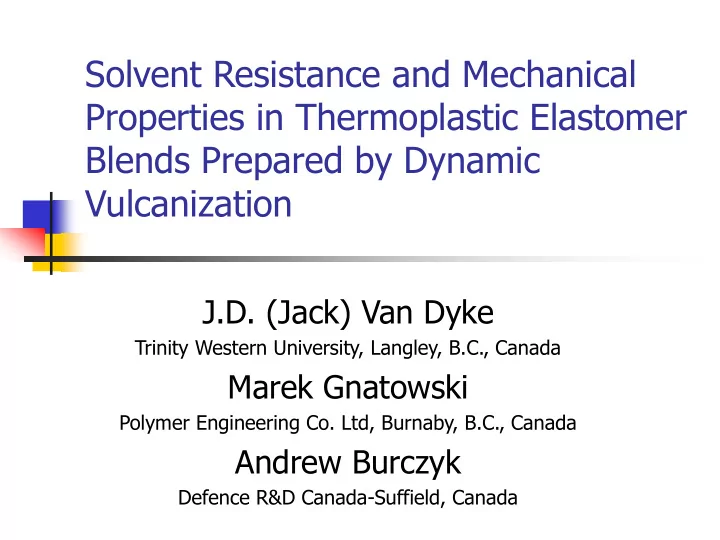

Solvent Resistance and Mechanical Properties in Thermoplastic Elastomer Blends Prepared by Dynamic Vulcanization J.D. (Jack) Van Dyke Trinity Western University, Langley, B.C., Canada Marek Gnatowski Polymer Engineering Co. Ltd, Burnaby, B.C., Canada Andrew Burczyk Defence R&D Canada-Suffield, Canada
Mixing Methods High shear melt mixing Without curing agents non-vulcanized blends Continuous phase dependent on proportions in the blend With curing agents dynamic vulcanization Non-vulcanized component becomes continuous phase, almost independent of proportion in blend
Non-Vulcanization vs. Dynamic Vulcanization
Objective of Present Work Dynamic Vulcanization on a Variety of Thermoplastic / Rubber Combinations Thermoplastics (PA, PP, and PBT) Rubber (CIIR, NBR) Measure Mechanical properties Exposure to solvents (hexane and CHCl 3 ) % insolubility, swelling index DSC and SEM
Effect of % Thermoplastic on Properties Hardness (Shore D) Tensile Strength PP-CIIR Blends PP-CIIR Blends (MPa) 35.0 80 70 30.0 Tensile Strength (MPa) Hardness (Shore D) 60 25.0 50 20.0 40 15.0 30 10.0 20 5.0 10 0 0.0 50-90 18 20 25 30 35 40 50 100 60-90 18 20 25 30 35 40 50 60 100 % Polypropylene % Polypropylene
Tensile Strength Comparison in Blends 20.0 18.0 16.0 14.0 12.0 Tensile Strength 10.0 8.0 50 40 6.0 35 30 4.0 25 % Plastic 2.0 20 15 0.0 0 PA- PP- PA- CIIR PP- CIIR PBT- NBR NBR NBR Blend Type
DSC Results – Thermoplastic Phase Phase separation Tm ( ° C) Δ H f ( J/g plastic) Dynamic vulcanization PA 178.7 60.6 effects PA/CIIR 175.6 58.1 rubber phase PA/NBR 176.5 58.5 (curing, particle formation) PP 163.3 80.9 thermoplastic phase PP/CIIR 161.6 83.1 (MW reduction, graft PP/NBR 161.5 80.6 formation, crystallization PBT 223.0 38.1 effects) PBT/NBR 222.6 46.0
SEM OF PA/NBR BLEND PA-NBR Blend PP-NBR Blend
Solvent Uptake – Kinetic Studies Rate of solvent uptake 6 determined on 5 rubber and blend samples 4 Swelling Index Blends achieve 3 equilibrium relatively 2 quickly 100 NBR 40 PA /60 NBR Example of 1 100 NBR and 0 40 PA/60 NBR 0 8 16 24 32 40 48 56 64 72 80 88 96 Time (hrs)
Swelling Index: PA – CIIR Blend at Different Compositions Swelling Index PA-CIIR Blends S.I. Values consistently below 7 theoretical line 6 (physical mixture) 5 Swelling Index Continuous 4 thermoplastic 3 phase prevents solvent expansion 2 of cured rubber 1 phase 0 0 10 20 30 40 50 60 70 80 90 100 % Polyamide
Swelling Index Values for Other Blends PA-NBR Blends Swelling Index Swelling Index PP-CIIR Blends 7 6 6 5 5 Swelling Index 4 Swelling Index 4 3 3 2 2 1 1 0 0 0 10 20 30 40 50 60 70 80 90 100 0 10 20 30 40 50 60 70 80 90 100 % Polypropylene % Polyamide
Swelling Index Values for Other Blends PP-NBR Blends Swelling Index PBT-NBR Blends Swelling Index 30 30 25 25 Swelling Index 20 20 Swelling Index 15 15 10 10 5 5 0 0 0 10 20 30 40 50 60 70 80 90 100 0 10 20 30 40 50 60 70 80 90 100 % PBT % Polypropylene
Relationship Between Swelling Index and % Elongation Minimum elongation Swelling Index PBT-NBR Blends Elongation (%) reached at similar composition as 30 600 change in S.I. 25 500 Curve 20 400 Elongation (%) Swelling Index 15 300 Phase inversion 10 200 Similar results for 5 100 all blends studied. 0 0 0 10 20 30 40 50 60 70 80 90 100 % PBT
Conclusions 1. Dynamic vulcanization – variety of rubber plastic blends, many with elastomeric properties. Elastomeric properties seen between 20-40% thermoplastic 2. Both rubber and plastic phases affected during the dynamic vulcanization process. 3. Solvent exposure – rapid swelling upon exposure to solvent (tested on hexane and CHCl 3 ). Similar performance expected with other solvents.
Conclusions (continued) 4. S.I. values of blends are significantly less than expected “theoretical” values. “caging effect” at higher thermoplastic compositions. 5. Minimum elongation values reached at phase inversion. 6. Increased compatibility in blends reduced particle size (discrete phase) frequently produces less caging effect on the rubber phase
Acknowledgements Defence R&D Canada – Suffield Laboratory staff at PEC Dave Lesewick, Christine Mah, Beverley Start Laboratory staff at TWU Leanne Edwards, Simon Moore, Kim Klassen DRDC – Esquimalt (SEM results) Bruce Kaye Website: www.polymer-engineering-co.com/
Recommend
More recommend